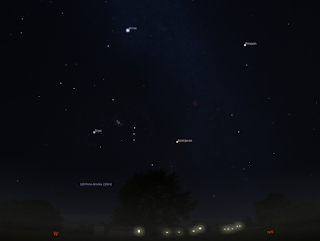Wednesday, May 01, 2024
Thursday May 2 to Thursday May 9
The New Moon is Wednesday, May 8. Comet 12P Pons-Brooks is visible in binoculars and will progressively climb higher over the week heading for the iconic Orion constellation. Between 3 and 6 May the waning Moon joins the lineup of Saturn, Mars and Mercury. On the 4th there is a spectacular close approach of the Moon to Saturn, with a daytime occultation in the eastern states. On the 5th The Moon is close to Mars and on the 6th it is close to Mercury. On the 6th-8th the eta Aquariid meteor shower is visible in the morning sky.
The New Moon is Wednesday, May 8. The Moon is at perigee, when it is closest to Earth, on the 6th.
Evening sky on Saturday, May 4 as seen from Adelaide at 18:27 ACST (60 minutes after sunset, click to embiggen). Comet 12P is rising higher in the evening twilight.While the comet is a reasonable bright magnitude 4.7, it is still not too far from the horizon. You will definitely need binoculars. Over the week the comet will climb higher into darker skies and. Updated spotters charts are here.
Similar views will be seen from the rest of Australia at the equivalent local time (60 minutes after sunset).
While the comet is a modestly bright magnitude 5, despite now being visible when the sky is fully dark, you will still need binoculars. Over the week the comet will climb towards Orion and into darker skies, but becomes dimmer as it rises. Updated spotters charts are here.
Similar views will be seen from the rest of Australia at the equivalent local time (90 minutes after sunset).
Morning sky on Saturday, May 4 as seen from Adelaide at 05:57ACST, (60 minutes before sunrise, click to embiggen). The Moon is very close to Saturn with Mars and Mercury below. The eastern states see a daytime occultation of Saturn in the morning.
The eta Aquariid meteor shower, which is produced by the debris from Halley’s Comet, will peak on May 6 (strictly speaking May 5, 21UT).
Elsewhere in Australia will see a similar view at the equivalent time (90 minutes after sunset).
Mercury climbs higher into the twilight. On the 6th the Moon is close to Mercury.
Venus is lost in the morning twilight.
Mars is rising in the morning twilight. On the 5th The Moon is close to Mars.
Jupiter is lost in the twilight sky.
Saturn climbs higher in the morning twilight. On the 4th there is a spectacular close approach of the Moon to Saturn, with a daytime occultation in the eastern states.
Star Map via Virtual sky. Use your mouse to scroll around and press 8 when your pointer is in the map to set to the current time.
Cloud cover predictions can be found at SkippySky.
Here is the near-real time satellite view of the clouds (day and night) http://satview.bom.gov.au/
Labels: weekly sky
<< Home









 Click to read about or order
Click to read about or order Click to read about or order
Click to read about or order Click to read about or order
Click to read about or order Click to read about or order
Click to read about or order